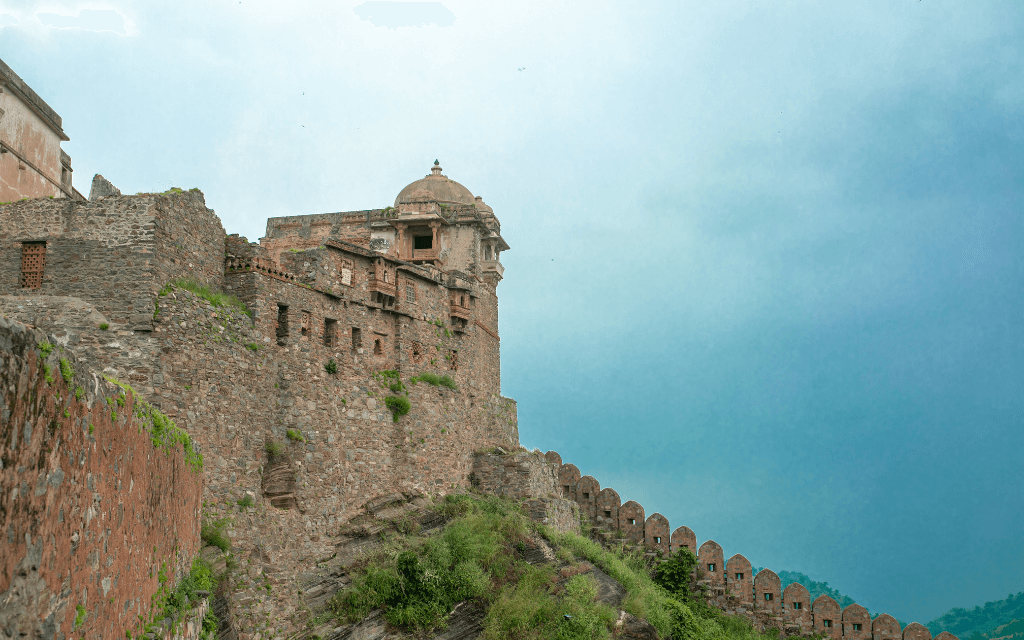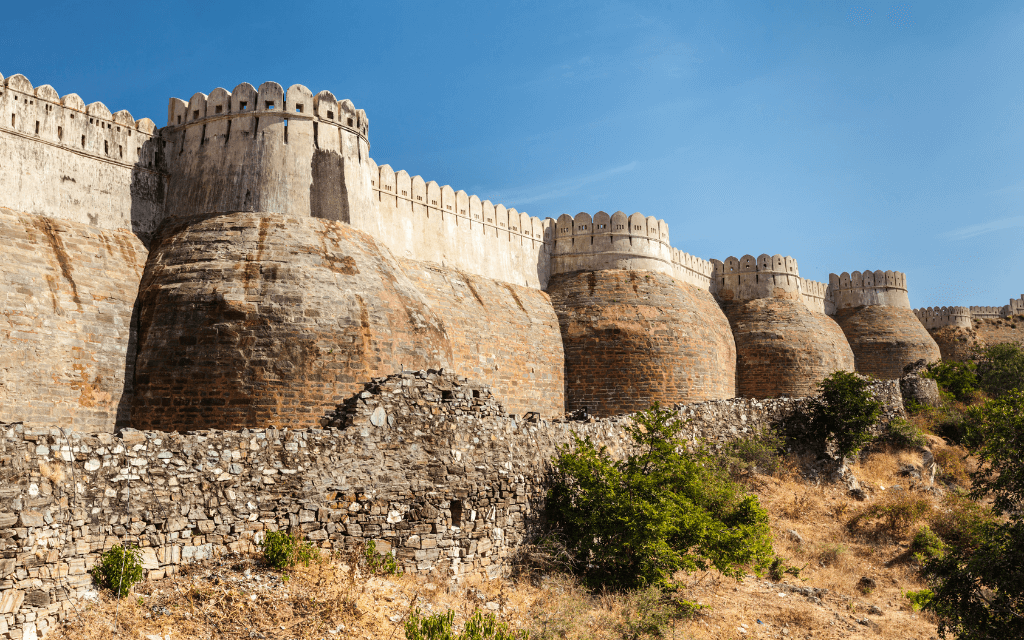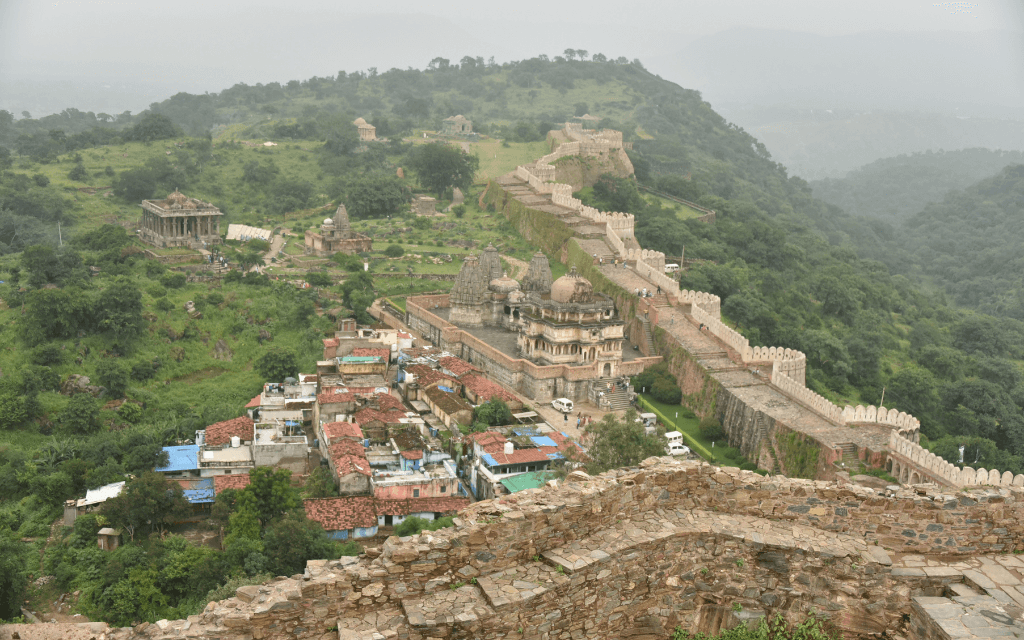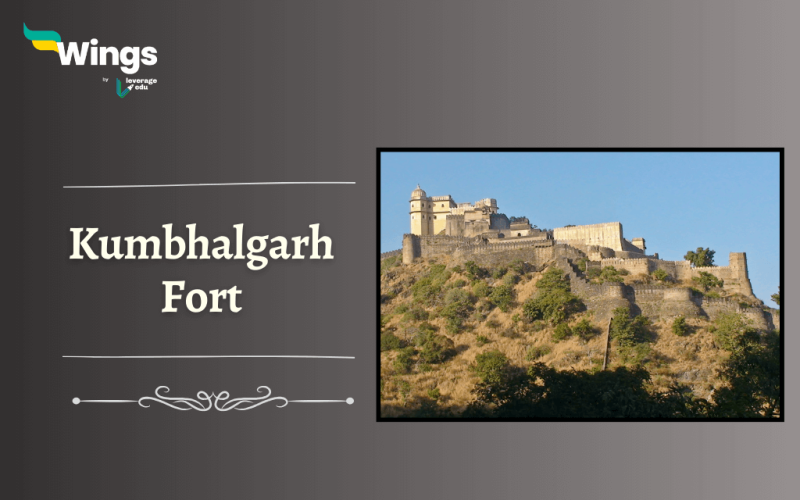Kumbhalgarh Fort’s history is shrouded in mystery and by its rugged beauty. The Fort is located in the Rajsamand district near Udaipur of Rajasthan, India. It is strategically located on the Western Aravalli Hills and has faced many events in its lifetime. Let’s delve into knowing about Kumbhalgarh Fort history, features, facts, timings and more.
Contents
| Commissioned by | Rana Kumbha of Mewar |
| Architect | Mandan |
| Location | Kumbhalgarh, Rajsamand, Rajasthan |
| Timings | 9:00 am to 5:00 pm; open everyday |
| 9:00 am to 5:00 pm; open every day | INR 10 for Indians; INR 100 for foreigners (changes applicable) |
| Video Camera | Entry Fee for the fort |
| Status | UNESCO World Heritage Site |
History of Kumbhalgarh Fort
The fort is originally believed to have been built by King Samprati, grandson of the Emperor Ashoka of the Mauryan Age in the 6th century, but its documented history begins in the 15th century by Rana Kumbha or Kumbhakaran, a renowned ruler of Mewar.
- The fort was designed by the famous architect Mandan. This towering structure was constructed with the vision of creating an impregnable stronghold that would protect the kingdom from invaders.
- The fort’s strategic location atop the Aravalli Hills offered a vantage point that allowed for surveillance of both the surrounding landscape and the enemy’s movements.
- Local lore claims a human sacrifice eased construction difficulties.
- And the fort was used as a safe haven by the Mewar rulers due to its strategic location.
- It witnessed many historic events, like it became the birthplace of Maharana Pratap, a famous Rajput warrior.
- Became a shelter for Prince Udai of Mewar from invaders.
Kumbhalgarh Fort is believed to be the fort that was invincible ever, but it was once briefly conquered by Mansingh I, the Mughal Emperor Akbar’s general in 1576. Its later history shows that it passed through the hands of colonial rulers before becoming part of Rajasthan.

Also Read – Bhangarh Fort History: Features, Facts, Timings & More
Features of Kumbhalgarh Fort
Kumbhalgarh Fort is famed for its magnificent and well-preserved walls, which stretch over 36 kilometres and are believed to be the Second-Longest continuous wall in the world, after the Great Wall of China.
| Feature | Description |
| Ram Pol | The entrance to the fort |
| Gateways | The fort has Hanuman Pol, Halla Pol and Aaret Pol serving as the gateways. |
| Kumbha Palaces | The residence of the ruler showcases intricate carvings and reflects the Mewar dynasty’s artistic heritage. |
| Badal Mahal (Palace of Clouds) | Badal Mahal, also known as the Palace of Clouds built by Rana Fateh Singh offers a breathtaking panoramic view of the surrounding countryside. |
| This serene palace served as a retreat for the royal family and features intricately carved jharokhas (balconies) and vibrant frescoes that depict scenes from Hindu mythology. | |
| Lakhola Tank | Rana Lakha constructed the tank for water preservation with other Chattris and Baoris. |
| Hindu Temples | Neelkanth Mahadeva Temple, dedicated to Lord Shiva and ancient Ganesh Temple |
| Jain Temples | Parsvanath Jain Temple, Mmadeo Temple, Mataji Temple, Pital Shah Temple, Mamdeo Temple and Golera Jain Temple all showcase religious diversity and tolerance. |
| Badshahi Bavdi | Many step-wells provide a water source and symbolise resilience, with Badshahi Bavdi being the most notable. |
| Hidden Passages (Rumored) | Adding an element of mystery and intrigue, possibly used for escape during sieges. |
Legends and Significance
- The Birthplace of Maharana Pratap: Kumbhalgarh Fort is believed to be the birthplace of one of Rajasthan’s most revered warrior kings, Maharana Pratap. His valiant efforts and unwavering courage are still celebrated.
- Unconquered Fortress: With its robust fortifications and strategic design, Kumbhalgarh remained unconquered throughout its history. The impenetrable walls and sheer grandeur of the fort showcased and added to the power and might of the Mewar dynasty.
- Kumbhalgarh Wildlife Sanctuary: The fort is surrounded by Kumbhalgarh Wildlife Sanctuary, a haven for diverse flora and fauna. The sanctuary is home to several endangered species, including the Indian wolf and the leopard.
Also Read – Agra Fort History: Features, Facts, Timings & More
Interesting Facts about Kumbhalgarh Fort
- Legend has it that over three thousand lamps were lit along the fort walls every evening, creating a mesmerizing spectacle that could be seen from miles away.
- The fort is said to have a secret underground tunnel that leads to the nearby village of Ghanerao. This tunnel served as an escape route during times of siege or unrest.
- There are nearly 360 temples inside the fort, out of which ancient Jain temples are 300 and the rest are of other deities.
- Kumbhalgarh Fort was recognized as a UNESCO World Heritage Site in 2013.

Timings of Kumbhalgarh Fort
The Archaeological Survey of India (ASI) took the initiative of illuminating the fort after sunset with lights. Another attraction is the accredited best light and sound show at the fort. The timings for visiting the Monument and watching the mesmerising light and sound shows are –
| Purpose | Timings |
| Entry | 9 am to 6:00 pm |
| Week Entry | Everyday |
| Light and Sound Show | 6:00 pm to 7:00 pm; every day (changes applicable) |
| Duration of the Show | 45 minutes |

Other Attractions near Kumbhalgarh Fort
| Kumbhalgarh Wildlife Sanctuary (3 km) | Ganga Govardhan Museum (3.3 km) |
| Parshuram Tempe | Vendi Temple |
| Ranakpur Jain Temple | Haldighati (Yellow Mountain) |
In conclusion, Kumbhalgarh Fort stands as a magnificent chapter of Rajasthan’s glorious past. The walls of the fort speak volumes about the bravery of the rulers and how the fort helped them in their battles throughout. The fort is a historical treasure that displays the grandeur of the Mughal and Rajput architectural styles.
FAQs
Kumbhalgarh Fort, built in the 15th century by Rana Kumbha in Rajasthan, was a strategic stronghold of the Mewar kingdom. It is famed for its massive wall—the second longest in the world—and as the birthplace of Maharana Pratap.
Kumbhalgarh Fort is renowned for its 36 km long wall, the second longest in the world after the Great Wall of China. It also houses over 300 temples and offers panoramic views of the Aravalli hills.
The Shivling in Kumbhalgarh Fort, located in the Neelkanth Mahadev Temple, is about 6 feet tall. It is a revered symbol of Lord Shiva and a key spiritual site within the fort.
Relevant Blogs
| Ellora Caves | Amer Fort History |
| 5 Most Famous Types Of Paintings in India | Traditional Art Forms of India |
| All the Names of India Throughout History | Golconda Fort |
| History of Indian Art | Red Fort History |
That’s all about Kumbhalgarh Fort history! If you want to know more about topics like this, then visit our general knowledge page! Alternatively, you can also read our blog on general knowledge for competitive exams!
 One app for all your study abroad needs
One app for all your study abroad needs














